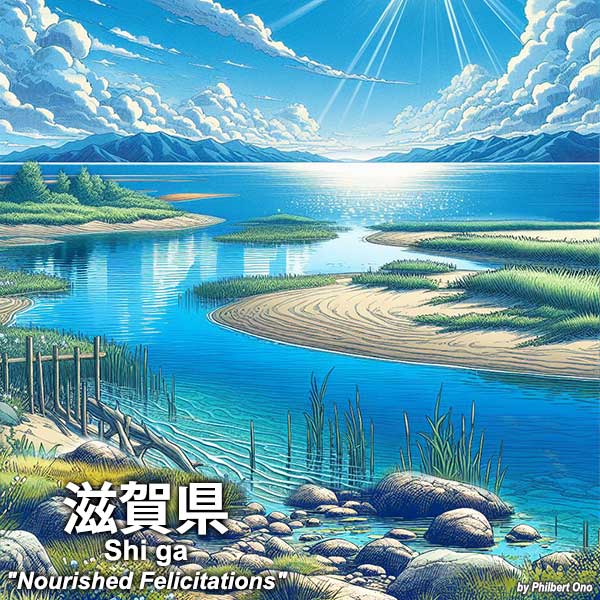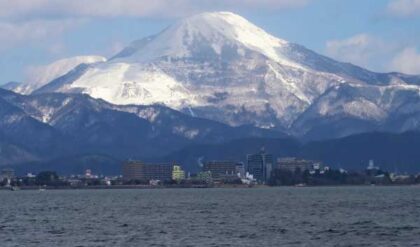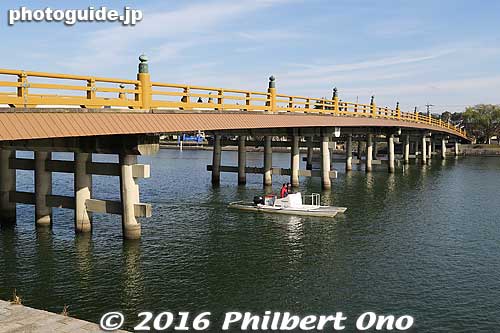SHIGA – Nourished Felicitations 滋賀県

If there are multiple theories for the origin of the prefectural name, it means nobody knows for sure what the origin or the exact meaning is. This applies to “Shiga” as well.
“Shi” (滋) literally means nutritious, nourishing, or good for the health. And “ga” (賀) means celebration or felicitations like New Year’s.
Although it looks and sounds like a good meaning, it’s hard to make any sense out of “Shiga.” Maybe it refers to nutritious food (lake fish, etc.) served on auspicious occasions. I’m only guessing. Lake Biwa, Japan’s largest lake in Shiga, is definitely “nutritious” though, for the local flora and fauna including endemic species.
Theory 1: The “Shiga” name (滋賀) originated from “Shika” (石処) meaning “place with many stones.” Since many other places named “Shiga” mean “place with many stones,” it’s likely that this is the case for Shiga as well. We can only wonder which rocky place in Shiga it refers to. Shiga’s most rocky area is along the northern shore where there are many cliffs and large rocks fronting the lakeshore.
Theory 2: “Shiga” originated from “Suka” (砂処 or 州処) which is a sandbar or marshland along the lakeshore. In the case of other places named “Shiga,” it’s unlikely that they morphed from “Suka.” So this might be unique to Shiga. Lake Biwa’s many rivers did create some sandbars which resulted in small, attached lakes along the lake fringe. They do have reeds and marshes.
Theory 3: “Shiga” originated from Shika-no-shima (志賀島), an inhabited island in Fukuoka, Kyushu. The island is connected to the mainland by a sandbar. Until the 7th century, members of the Azumi Clan (阿曇氏) originating from Fukuoka lived in various places in Japan and named their locality after this island in their ancestral hometown. They included the Wani and Ono Clans (小野氏) who named their locality “Shiga” or “Shika” with kanji characters such as 四賀 and 志賀. “Wani” and “Ono” still remain as place names in Shiga.
A common kanji variant of “Shiga” is 志賀 (Wishful Felicitations). At one time, both 志賀 and 滋賀 were used interchangeably for “Shiga.” The former is older.
Until 2006 before the major Heisei municipal mergers in Shiga and most of Japan, there was a Shiga-cho Town (志賀町) next to Otsu. It was formed in 1955 upon the merger of Wani, Kido, and Komatsu Villages. It included places like Omi-Maiko beach and Biwako Valley ski grounds.
Shiga-cho was in a district named “Shiga-gun” (滋賀郡) which made it confusing to non-locals because the kanji characters for the town and district differed even though they were pronounced the same (滋賀県滋賀郡志賀町).
In 2006, Shiga-cho merged into Otsu and was abolished. The 志賀町 town and place name was deleted from local addresses and maps. The 志賀 name still exists in Shiga as Shiga Station (志賀駅) on the JR Kosei Line.
So much for the possible meanings, but I couldn’t find any information about why the current kanji characters were selected for “Shiga.” Why not 志賀 or some other kanji combination?
By November 1871, former Omi Province samurai domains came under Nagahama Prefecture in the northern half or Otsu Prefecture in the southern half of present-day Shiga Prefecture.
In January 1872, Otsu Prefecture changed its name to “Shiga Prefecture” because the prefectural capital in Otsu was in Shiga District (滋賀郡). At the time, it was a national rule to name the prefecture after the district where the prefectural capital was located.
In February 1872, Nagahama Prefecture changed its name to “Inugami Prefecture” because its prefectural capital moved from Nagahama to Hikone which was in Inugami District. In September 1872, Inugami Prefecture merged into Shiga Prefecture.
In 1876, former Wakasa Province (Tsuruga, Obama, etc.) fronting the Sea of Japan in Fukui Prefecture merged into Shiga Prefecture. However, it returned to Fukui Prefecture in 1881 to finally establish the Shiga Prefecture boundaries we know today. For five short years, Shiga Prefecture enjoyed an ocean coast, a fun fact in Shiga.
Shiga’s former province name was “Omi” (also spelled “Ohmi” 近江) meaning “near the lake.” Some years ago, there was a far-fetched proposal to rename Shiga as “Omi Prefecture” to break out of its obscurity. That idea was quickly shot down.
When the Shiga Lakes (formerly “Lakestars”) pro basketball team was trying to decide on its team name in summer 2007, they took a poll asking Shiga residents whether the team name should have “Omi” or “Shiga.” The overwhelming majority favored “Shiga” over “Omi.”
Old province name: Omi-no-Kuni (近江国)
Nicknames: Kokoku (湖国) (Lake Country)
*The AI-generated image is for illustrative purposes only and may not accurately depict any particular place in the prefecture.
Sources: https://ja.wikipedia.org/wiki/%E6%BB%8B%E8%B3%80%E9%83%A1
Origin of other prefectural names (etymologies)
Overview | Aichi | Akita | Aomori | Chiba | Ehime | Fukui | Fukuoka | Fukushima | Gifu | Gunma | Hiroshima | Hokkaido | Hyogo | Ibaraki | Ishikawa | Iwate | Kagawa | Kagoshima | Kanagawa | Kochi | Kumamoto | Kyoto | Mie | Miyagi | Miyazaki | Nagano | Nagasaki | Nara | Niigata | Oita | Okayama | Okinawa | Osaka | Saga | Saitama | Shiga | Shimane | Shizuoka | Tochigi | Tokushima | Tokyo | Tottori | Toyama| Wakayama | Yamagata | Yamaguchi | Yamanashi





